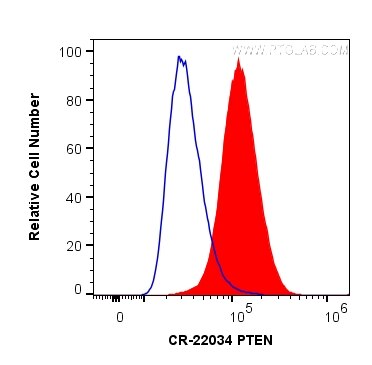- Featured Product
- KD/KO Validated
PTEN Polyklonaler Antikörper
PTEN Polyklonal Antikörper für FC (Intra)
Wirt / Isotyp
Kaninchen / IgG
Getestete Reaktivität
human, Maus
Anwendung
FC (Intra)
Konjugation
Cardinal Red™ Fluorescent Dye
Kat-Nr. : CR-22034
Synonyme
Galerie der Validierungsdaten
Geprüfte Anwendungen
| Erfolgreiche Detektion in FC | HeLa-Zellen |
Empfohlene Verdünnung
| Anwendung | Verdünnung |
|---|---|
| Sample-dependent, check data in validation data gallery | |
Produktinformation
CR-22034 bindet in FC (Intra) PTEN und zeigt Reaktivität mit human, Maus
| Getestete Reaktivität | human, Maus |
| Wirt / Isotyp | Kaninchen / IgG |
| Klonalität | Polyklonal |
| Typ | Antikörper |
| Immunogen | PTEN fusion protein Ag17274 |
| Vollständiger Name | phosphatase and tensin homolog |
| Berechnetes Molekulargewicht | 47 kDa |
| Beobachtetes Molekulargewicht | 55 kDa, 68 kDa |
| GenBank-Zugangsnummer | BC005821 |
| Gene symbol | PTEN |
| Gene ID (NCBI) | 5728 |
| Konjugation | Cardinal Red™ Fluorescent Dye |
| Excitation/Emission maxima wavelengths | 592 nm / 611 nm |
| Form | Liquid |
| Reinigungsmethode | Antigen-Affinitätsreinigung |
| Lagerungspuffer | BS mit 50% Glyzerin, 0,05% Proclin300, 0,5% BSA, pH 7,3. |
| Lagerungsbedingungen | Bei -20°C lagern. Vor Licht schützen. Nach dem Versand ein Jahr stabil. Aliquotieren ist bei -20oC Lagerung nicht notwendig. 20ul Größen enthalten 0,1% BSA. |
Hintergrundinformationen
Phosphatase and tensin homolog (PTEN) is an enzyme key in cell cycle regulation and in tumor suppression.
What is the molecular weight of PTEN?
PTEN is composed of 403 amino acid residues with an N-terminal domain with phosphatase activity and a
C-terminal C2 domain that binds phospholipid membranes (PMID:14749127). This antibody can recognize
two isoforms with MWs of 55kDa and 68 kDa.
What is the function of PTEN?
Widely expressed throughout the body, PTEN is found in the cytoplasm and inhibits cell cycle progression
through phosphatase activity. It regulates intracellular levels of phosphatidylinositol-3,4,5-trisphosphate (PIP3)
by catalyzing the dephosphorylation of the inositol ring. This function counteracts the growth-stimulating
activity of the PI3K/AKT signaling pathway and thereby suppresses proliferation. Therefore, in homeostasis,
PTEN promotes chromosome stability and DNA repair (PMID: 24387334).Expression and function can be
regulated by posttranslational modifications, including acetylation for decreased catalytic activity and
ubiquitination for protein degradation, nuclear localization, and inhibition of phosphatase activity
(PMID: 24656806).
What is the role of PTEN in cancer?
PTEN was first identified as a tumor suppressor when mutations or deletions were identified by two separate
groups in a number of different cancer types including gliomas, breast, prostate, and kidney cancer
(PMID: 9090379; PMID: 9072974). Non-inherited, or somatic, mutations in PTEN that lead to a loss of function
in the protein have been shown to drive malignancy in tumors. PTEN hamartoma tumor syndrome (PHTS) is a
group of inherited disorders that occur as a result of autosomal dominant mutations in the PTEN gene. These
disorders include Cowden syndrome, Bannayan-Riley-Ruvalcaba syndrome, and Proteus syndrome. Because of
the constitutive expression of PTEN, the symptoms are varied but often include neurodevelopmental issues and
an increased risk of developing tumors, both benign and malignant (PMID: 26564076).
Protokolle
| Produktspezifische Protokolle | |
|---|---|
| FC protocol for Cardinal Red™ PTEN antibody CR-22034 | Protokoll herunterladen |
| Standard-Protokolle | |
|---|---|
| Klicken Sie hier, um unsere Standardprotokolle anzuzeigen |


